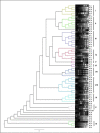Phenotypic and genetic screening of Klebsiella pneumoniae isolates from human UTI patients for beta-lactamases and their genetic diversity analysis by ERIC and REP PCRs
- PMID: 37198419
- PMCID: PMC10484876
- DOI: 10.1007/s42770-023-00984-6
Phenotypic and genetic screening of Klebsiella pneumoniae isolates from human UTI patients for beta-lactamases and their genetic diversity analysis by ERIC and REP PCRs
Abstract
Klebsiella pneumoniae is one of the major nosocomial pathogens responsible for pneumoniae, septicaemia, liver abscesses, and urinary tract infections. Coordinated efforts by antibiotic stewardship and clinicians are underway to curtail the emergence of antibiotic-resistant strains. The objective of the present study is to characterize K. pneumoniae strains through antibiotic resistance screening for production of beta-lactamases (β-lactamases) such as extended spectrum beta lactamases (ESBLs), AmpC β-lactamases, and carbapenemases by phenotypic and genotypic methods and genetic fingerprinting by enterobacterial repetitive intergenic consensus-polymerase chain reaction (ERIC-PCR) and repetitive element palindromic PCR (REP-PCR). A total of 85 K. pneumoniae strains isolated from 504 human urinary tract infections (UTI) were used in this study. Only 76 isolates showed positive in phenotypic screening test (PST), while combination disc method (CDM) as phenotypic confirmatory test (PCT) confirmed 72 isolates as ESBL producers. One or more β-lactamase genes were detected by PCR in 66 isolates (91.66%, 66/72) with blaTEM gene being the most predominant (75.75%, 50/66). AmpC genes could be detected in 21 isolates (31.8%, 21/66) with FOX gene being the predominant (24.24%, 16/66), whereas NDM-I was detected in a single strain (1.51%, 1/66). Genetic fingerprinting using ERIC-PCR and REP-PCR revealed wide heterogeneity among β-lactamase producing isolates with discriminatory power of 0.9995 and 1, respectively.
Keywords: AmpC β-lactamases; ERIC-PCR; ESBL; Klebsiella pneumonia; NDM-1; REP-PCR.
© 2023. The Author(s) under exclusive licence to Sociedade Brasileira de Microbiologia.
Conflict of interest statement
The authors declare no competing interests
Figures





References
-
- Ito H, de Sousa AT, dos Santos Costa MT, Makino H, Cândido SL, de Godoy MI, Lincopan N, Nakazato L, Dutra V. Multidrug-resistant mcr-1 gene-positive Klebsiella pneumoniae ST307 causing urinary tract infection in a cat. Braz J Microbiol. 2021;52(2):1043–1046. doi: 10.1007/s42770-021-00466-7. - DOI - PMC - PubMed
-
- Miftode IL, Nastase EV, Miftode RȘ, Miftode EG, Iancu LS, Luncă C, Păduraru DA, Costache I, Stafie CS, Dorneanu OS. Insights into multidrug-resistant K. pneumoniae urinary tract infections: from susceptibility to mortality. Exp Ther Med. 2021;22:1–9. doi: 10.3892/etm.2021.10520. - DOI - PMC - PubMed
MeSH terms
Substances
LinkOut - more resources
Full Text Sources
Medical
Molecular Biology Databases
Miscellaneous

